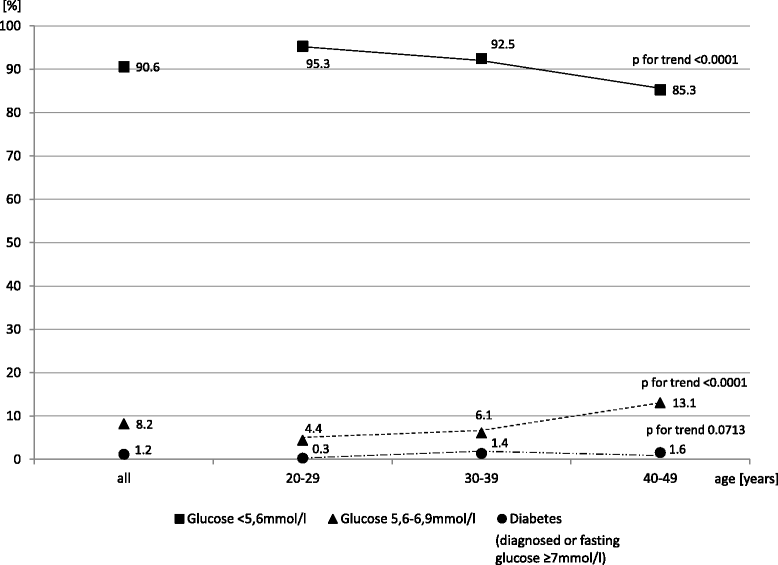Metabolic syndrome and its components in Polish women of childbearing age: a nationwide study
- PMID: 28705231
- PMCID: PMC5508652
- DOI: 10.1186/s12889-017-4564-5
Metabolic syndrome and its components in Polish women of childbearing age: a nationwide study
Erratum in
-
Erratum to: BMC Public Health, Vol. 18.BMC Public Health. 2017 Sep 22;17(1):736. doi: 10.1186/s12889-017-4709-6. BMC Public Health. 2017. PMID: 28938882 Free PMC article. No abstract available.
Abstract
Background: Abnormal body mass and related metabolic disorders may affect female reproductive health. The purpose of the study was to determine the prevalence of underweight, overweight, obesity, lipid and glucose metabolism disorders, hypertension, and metabolic syndrome, among Polish women of childbearing age.
Methods: One thousand five hundred eighty-eight non-pregnant Polish women of childbearing age (20-49 years) who participated in the Multi-Centre National Population Health Examination Survey (WOBASZ II study) in 2013-2014, were assigned to 3 age groups: 20-29 years (n = 403), 30-39 years (n = 600) and 40-49 years (n = 585). Measurements of weight, height, waist circumference, blood pressure, blood lipids, and blood glucose were taken. For statistical analysis, the Kruskal-Wallis, Chi-Square, and Cohran-Armitage tests were used.
Results: Of the participants, 4.3% were determined to be underweight, 25.2% were overweight, 15% were obese, and 53.1% had abdominal obesity. With age, the prevalence of both excessive body mass and abdominal obesity tended to increase, and that of underweight to decrease. Frequency of hypercholesterolemia and hypertriglyceridemia found in the whole group were 50% and 12.6% respectively, and also tended to rise with age. Low serum HDL-cholesterol (high density lipoprotein cholesterol) levels were found in 15.1% of the participants. Prevalence of impaired fasting glucose in the whole group was 8.2% and tended to increase with age. Diabetes was found in 1.2% of the participants and its prevalence also tended to rise with age, at the borderline of significance. Frequency of arterial hypertension and metabolic syndrome in the whole group was 15.7% and 14.1% respectively and both tended to increase with age.
Conclusions: Overweight and obesity, especially of abdominal type, and the related metabolic abnormalities are common in Polish women of childbearing age. Their prevalence tends to increase with age. Underweight is relatively common in the youngest age group.
Keywords: Body mass; Glucose metabolism; Lipid disturbances; Metabolic syndrome; Polish females of childbearing age.
Conflict of interest statement
Ethics approval and consent to participate
The study was accepted by the Bioethics Committee at the Institute of Cardiology in Warsaw (no 1344). All subjects were asked for their approval before starting the interview and a consent form was explained and then signed by all subjects.
Consent for publication
Not applicable.
Competing interests
The authors declare that they have no competing interests.
Publisher’s Note
Springer Nature remains neutral with regard to jurisdictional claims in published maps and institutional affiliations.
Figures
References
-
- Kramer MS. The epidemiology of adverse pregnancy outcomes: an overview. J Nutr. 2003;133(Suppl 2):1592S–1596S. - PubMed
-
- Neggers Y, Goldenberg RL. Some thoughts on body mass index, micronutrient intakes and pregnancy outcome. J Nutr. 2003;133(Suppl 2):1737S–1740S. - PubMed
-
- Szostak-Wegierek D. Nutrition and fertility. Med Wieku Rozwoj. 2011;15:431–436. - PubMed
MeSH terms
Substances
LinkOut - more resources
Full Text Sources
Other Literature Sources
Medical



